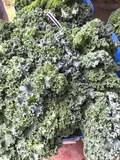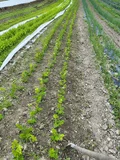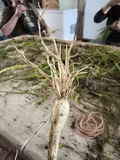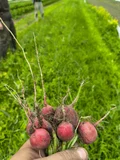TL;DR
We spent much of the day weeding and harvesting, so there was time to talk and joke and think..
From last week’s discussion with Jamie the farmer, I took on a short-term spike project to check out options for partnering with a commercial community kitchen or cannery to build out our options for value-added products (discsused in last Wednesday’s post). This is what I’ll focus on writing about today.
Terminology
- Value-added product - a product that has been processed or transformed from its raw state, adding value through cooking, packaging, or other means
- Co-packer / contract packager - a company that manufactures and packages products for other businesses, often on a contract basis (more info here)
- Commissary / community / shared-use kitchen - a shared kitchen space where food businesses can rent time and equipment to prepare their products list of Mass. options here
- Unit fee - a fee charged per unit of product produced
- Repack - the process of repackaging a product into a different container or labeling it with a different label, such as “Medely of Grilling Veg” or “Zoodles / Zucchini Noodles”
Selection Factors
The most important factor is that value-added products can’t disrupt existing operations such as CSA fulfillment or farm planning in the short-term. Adding any complexity to an already busy and constrained business model won’t go very far to helping the overall business.
These products need to be small batch (for now) so that we can run experimental recipes to figure out what sells and what doesn’t. So we want someone else who is licensed and certified to make and package these food products to do the cooking and preparation, execute on an existing recipe, and provide recommendations for improvement. Presumably since they do this a lot for others as well, they’ve got more experience than we do about what works and doesn’t when taking raw agricultural product and turning it into a finished product.
The space that is used also should be relatively local (reducing transportation costs) and licensed for producing these prepared foods. Optimally, both the contract packer and space used should generally align with the mission and economic goals of the farm.
Early Search Results
| Company | Location | Distance* | Services | Jars | Baked | Dried | Repack | |
|---|---|---|---|---|---|---|---|---|
| Commonwealth Kitchen | Boston, MA | 40mi | Co-packer | ✅ | ✅ | ❌ | ✅ | ✅ |
| Western MA Food Processing Center | Greenfield MA | 100mi | Co-packer | ✅ | ✅ | ❓ | ✅ | ✅ |
| Avon Food | Avon, MA | 55mi | Co-packer | ✅ | ✅ | ❌ | ✅ | ✅ |
| Food Revolution | Stoneham, MA | 25mi | Co-packer | ✅ | ✅ | ❌ | ✅ | ✅ |
* Distance is calculated from the farm’s address in Ipswich, MA.
Other potential options:
This is just a start and as I continue doing the research, I’ll likely create a page specifically for this information. Many of the sites I visited had old or outdated information, some had simply gone out of business, so I’ll also add a ‘linting’ step to check specific links for validity and alert me of changes in my site build process.
30 Minutes Later, Criteria and Options Refined
The above only took me about 30 minutes, but I’ve already learned a lot about the options and criteria. I did try to use ChatGPT with a prompt of:
As a eastern Massachusetts farmer, what are my local options for community kitchens or canneries to create value added products from my produce?
…but it largely focused on shared‑use & commissary kitchens. It did at the end however, offer a list of ‘need / goal’ to ‘best option’, which while not accurate, did give me a few ideas to discuss with Jamie tomorrow. I’ve always thought of AI as more of a fake-friend to help me brainstorm at the whiteboard than a replacement for human interaction, chatbots be damned. People use Google search for that all the time and don’t think twice about it, then complain that their ads are eerily accurate.
What AI Doesn’t Know Hurts It
If you look at prior blog posts, you might notice that the title and description (below) are a bit…less intelligent than what I usually post. It’s because AI generated them, based on and really despite my high quality voice notes transcription.
AI-generated description: Activities and topics today were planning activities related to radishes, field, things.
“Things”. Really, you can’t make this up, Deepseek-R1:8b thought that for a ‘blog post title which is not clickbait’ and provided both the transcript and AI-generated summary should have the words ‘field’ and ‘things’ in it. But don’t worry, it’s my fault, I need to adjust my prompt template.
Yesterday’s Hallucinations Are Today’s Faulty Inputs
The problem with yesterday’s summary, the complete hallucination that was Part 2, was easy to diagnose in the <think> block describing the reasoning.
“From the example provided, the origin link seems to be a hash, which might point to a specific document or data source. However, without accessing that link, I can’t directly read the content of the notes.”
It accurately guesses as to who might be asking the questions. Each summary I send also includes a simple ‘origin: [guid]’ front matter tracking code for internal purposes. So because it got side-tracked about thinking that the origin link is a hash and thinks it should link to something it doesn’t have, it guesses about generic activities:
“In the example given, the intern mentions tasks like moving calves, feeding livestock, cleaning stalls, planting trees, and applying fertilizers.”
Then it builds on these false assumptions to make up a story about what the questions might be. I still don’t understand why it wouldn’t just take the second breakout document from the transcript and use that as the basis of context as the prompt directs it to do so. I do understand that once it gets lost and then has to summarize the individual summaries, it will quickly compound errors it makes.
Today it didn’t get side-tracked, and it never did before yesterday’s debacle, so I’m not sure what changed but I do know I’ll have to tweak the prompt to make it more clear what it should be doing.
---
origin: 1IassjQn1b6NBsiO_T5UKKi_U5ul5ql3v
---
Summary
Final Consolidated Summary
Main Themes:
-
Harvesting Operations: The intern is involved in harvesting various crops such as kale, radishes, beets, eggplant, celery, onions, and scallions, highlighting routine labor and operational activities.
-
Quality Control Issues: Damaged and bolted radishes pose significant marketability challenges, impacting the farm’s output quality.
-
Efficiency Concerns: Extra time is dedicated to handling damaged crops, indicating potential inefficiencies in production or management practices.
-
New Concepts Identified: The term “bolting,” referring to plants quickly sending out shoots due to stress, leading to less edible produce, is identified as a new area requiring exploration.
Activities Performed:
- Harvesting various crops.
- Using tools like stirrup hoses for weed control.
- Processing damaged radishes by transporting them to the barn, bunching, and washing.
New Concepts:
- “Bolting” is introduced as a factor causing poor-quality produce. Further exploration is needed to understand its causes and solutions.
Questions:
- What are the primary causes of bolting in plants?
- How can bolting be effectively prevented or mitigated?
Suggested Actions:
- Improve spacing between plants to reduce stress-induced bolting.
- Harvest tender radishes early if bolting is detected to maintain quality.
- Implement better drainage and water management practices to prevent plant stress.
This summary encapsulates the key aspects of farming operations, highlighting challenges, activities, new concepts, and actionable steps for improvement.
Part 1
Main Themes:
- Quality Control Issues: The transcript highlights issues with radish quality, particularly those that have bolted, leading to damage and unsellable produce.
- Efficiency Concerns: The extra time spent on picking damaged radishes suggests potential inefficiencies in production or plant health management.
Activities Performed:
- Picking damaged radishes.
- Transporting them to the barn.
- Bunching together for washing.
- Washing the radishes in a pack.
New Concepts Identified:
- Bolting: A term referring to plants growing too quickly, often due to stress, leading to tough or unsellable produce.
Potential Questions/Research Areas:
- What causes bolting in radishes?
- How can bolting be prevented or mitigated?
- Are there specific practices that reduce the likelihood of bolting?
Suggestions for Improvement:
- Consider spacing plants appropriately to prevent stress-induced bolting.
- Harvest tender radishes early ifbolting is detected to maintain quality.
- Improve drainage and manage water levels to avoid stress causing bolting.
This analysis provides insights into the challenges faced by the intern, suggesting areas for research and actionable steps to enhance farm operations.
Part 2
Main Themes:
- Harvesting Operations: The intern focused on harvesting various crops such as kale, salad turnips, scallions, and radishes.
- Weeding Efforts: They engaged in extensive weeding tasks across different fields, including eggplant, celery, onions, and other rows covered by landscape fabric.
- Perishability Concerns: The intern highlighted the importance of harvesting fresh produce like scallions to maintain quality, given their short shelf life.
Activities:
- Harvested 100 bunches of kale.
- Weeded areas in various fields, including around radishes and beets.
- Harvested salad turnips.
- Washed produce brought back to the barn.
- Used a stirrup hose for weed control.
- Harvested a 300-foot row of celery.
- Weeded one and a half rows of onions.
- Harvested scallions, noting their perishability.
- Continued weeding in the eggplant field and other fields.
New Discoveries:
- Stirrup Hose: A tool used for weed control, likely helping manage weeds efficiently.
- Bolting Radishes: Term meaning radishes have flowered and are going to seed, affecting their edibility.
Questions and Future Research:
- How long do scallions remain fresh after harvesting?
- What methods can be employed to prevent bolting in radishes?
- Are there best practices for harvesting scallions to ensure maximum freshness?
Suggestions for Actions:
- Harvest scallions as soon as possible to maintain their freshness.
- Consider using techniques or fertilizers that may reduce bolting in plants like radishes.
- Explore methods to cover plants more effectively during weeding to prevent future issues.
[end of post]
Enjoy Reading This Article?
Here are some more articles you might like to read next:






